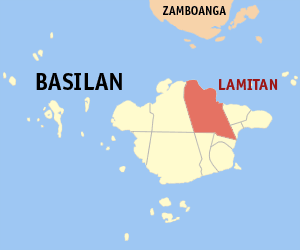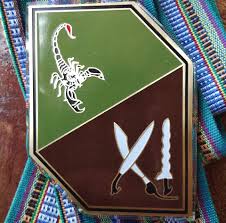
Abu Sayyaf, officially known by the Islamic State as the Islamic State – East Asia Province, was a Jihadist militant and pirate group that followed the Wahhabi doctrine of Sunni Islam. It was based in and around Jolo and Basilan islands in the southwestern part of the Philippines, where for more than five decades, Moro groups had been engaged in an insurgency seeking to make Moro Province independent. The group was considered violent and was responsible for the Philippines' worst terrorist attack, the bombing of MV Superferry 14 in 2004, which killed 116 people. The name of the group was derived from Arabic abu, and sayyaf. As of April 2023, the group was estimated to have about 20 members, down from 1,250 in 2000. They used mostly improvised explosive devices, mortars and automatic rifles.

Operation Enduring Freedom – Philippines (OEF-P) or Operation Freedom Eagle was part of Operation Enduring Freedom and the global War on Terror. The Operation targeted the various Jihadist terror groups operating in the country. By 2009, about 600 U.S. military personnel were advising and assisting the Armed Forces of the Philippines (AFP) in the Southern Philippines. In addition, by 2014, the CIA had sent its elite paramilitary officers from their Special Activities Division to hunt down and kill or capture key terrorist leaders. This group had the most success in combating and capturing Al-Qaeda leaders and the leaders of associated groups like Abu Sayyaf.

Jolo, officially the Municipality of Jolo, is a 1st class municipality and capital of the province of Sulu, Philippines. According to the 2020 census, it has a population of 137,266 people.

Patikul, officially the Municipality of Patikul, is a 3rd class municipality in the province of Sulu, Philippines. According to the 2020 census, it has a population of 79,564 people.
The Dos Palmas kidnappings was a hostage crisis in southern Philippines that began with the seizing of twenty hostages from the affluent Dos Palmas Resort on a private island in Honda Bay, Palawan, by members of Abu Sayyaf on May 27, 2001, and resulted in the deaths of at least five of the original hostages. Three of these hostages were American citizens, Guillermo Sobero, and a married missionary couple, Gracia and Martin Burnham. At least 22 Filipino soldiers were killed in attempts to apprehend the captors and free the hostages in the 12 months following the initial hostage taking. An unknown number of captors were killed by government forces.

The Moro conflict was an insurgency in the Mindanao region of the Philippines which involved multiple armed groups. Peace deals have been signed between the Philippine government and two major armed groups, the Moro National Liberation Front (MNLF) and the Moro Islamic Liberation Front (MILF), but other smaller armed groups continue to exist. In 2017, the peace council settled around 138 clan conflicts.

The Mindanao bombings was a series of seemingly unrelated bomb attacks that took place on July 4, 5, and 7, 2009 in the towns of Datu Piang and Jolo, and the cities of Cotabato and Iligan in Mindanao, Philippines. The bombings killed around 7 people and injured at least 66. The Armed Forces of the Philippines has blamed several militant organizations active in Mindanao, such as the Moro Islamic Liberation Front (MILF), the Abu Sayyaf, and Jemaah Islamiyah.
The 2000 Sipadan kidnappings was a hostage crisis in Sabah, Malaysia, and the southern Philippines that began with the seizing of twenty-one hostages from the dive resort island of Sipadan at approximately 6:15 p.m. on 23 April 2000, by up to six Abu Sayyaf (ASG) bandits. Taken hostage were 10 tourists from Europe and the Middle East and 11 Malaysian resort workers, 19 non-Filipino nationals in total. The hostages were taken to an Abu Sayyaf base in Jolo, Sulu.
This article contains a timeline of events from January 2016 to December 2016 related to the IS-linked Abu Sayyaf. This article contains information about the events committed by or on behalf of the Abu Sayyaf, as well as events performed by groups who oppose them.
The following is a list of attacks which have been carried out by Abu Sayyaf, a militant group based in and around Jolo and Basilan islands in the southwestern part of the Philippines, where for more than four decades, Moro groups have been engaged in an insurgency for an independent province in the country.

The Maute group, also known as the Islamic State of Lanao, was a radical Islamist group composed of former Moro Islamic Liberation Front guerrillas and foreign fighters led by Omar Maute, the alleged founder of a Dawlah Islamiya, or Islamic state, based in Lanao del Sur, Philippines. The group, which a Philippine Army brigade commander characterized as terrorist, had been conducting a protection racket in the remote settlements of Butig, Lanao del Sur. It has clashed on several occasions with the Armed Forces of the Philippines, the most significant of which began in May 2017 and culminated in the siege of Marawi.

The siege of Lamitan took place on 2 June 2001 when members of the Islamic terrorist group Abu Sayyaf entered the city of Lamitan, one of two Christian settlements in the predominantly Muslim province of Basilan in the Philippines. They took over a church and a hospital and held priests, medical staff and patients hostage. Government forces surrounded the Muslim extremists, preventing their escape. However, the Abu Sayyaf group managed to break out of the cordon by using their hostages as human shields.
The Philippines is one of the state opponents of the militant group, Islamic State of Iraq and the Levant (ISIL), more commonly referred to by the local media as the Islamic State of Iraq and Syria (ISIS).
This is a chronology of the Moro conflict, an ongoing armed conflict in the southern Philippines between jihadist groups such as the Abu Sayyaf Group, the Maute Group, Jemaah Islamiyah, and Islamic State affiliates, mainstream separatist groups such as the Moro Islamic Liberation Front (MILF), the Moro National Liberation Front (MNLF) and the Bangsamoro Islamic Freedom Fighters (BIFF), and the Philippine Government since 1971. Much of the fighting has been concentrated on the island of Mindanao and the Sulu archipelago, with spillover incidents and attacks occurring in the Philippine capital Manila and neighboring countries such as Malaysia.
On July 31, 2018, a bomb exploded in the town of Lamitan in Basilan, Philippines.

The 11th Infantry Division, Philippine Army, also called the Alakdan Division, is one of the Philippine Army's infantry units in Mindanao. Currently still forming, the Division is expected to complete its equipment and manpower requirements by 2022. It is the youngest of all the infantry divisions of the Army and will have 4,500 troops when fully formed.

In the morning of January 27, 2019, two bombs exploded at the Roman Catholic Cathedral of Our Lady of Mount Carmel in Jolo, Sulu, Philippines. Twenty people were killed and 102 others injured. The bombings took place a week after the autonomy plebiscite held on January 21 for the creation of Bangsamoro. It is believed that the Abu Sayyaf carried out the attacks, and the Islamic State claimed responsibility. President Rodrigo Duterte responded by issuing an "all-out war" directive against the Abu Sayyaf. The bombings were widely condemned by other countries and organizations.

The Cathedral of Our Lady of Mount Carmel, also known as Jolo Cathedral, is a Roman Catholic cathedral in Jolo, Sulu and the seat of the Apostolic Vicariate of Jolo. The cathedral is located in Jolo, a volcanic island in Sulu Province of the Bangsamoro Autonomous Region in Muslim Mindanao in the Philippines. The cathedral is dedicated to the Virgin Mary under the title Our Lady of Mount Carmel.
The 2020 Jolo bombings occurred on August 24, 2020, when insurgents alleged to be jihadists from the Abu Sayyaf group detonated two bombs in Jolo, Sulu, Philippines, killing 14 people and wounding 75 others. The first occurred as Philippine Army personnel were assisting in carrying out COVID-19 humanitarian efforts. The second, a suicide bombing, was carried out near the Our Lady of Mount Carmel Cathedral.










